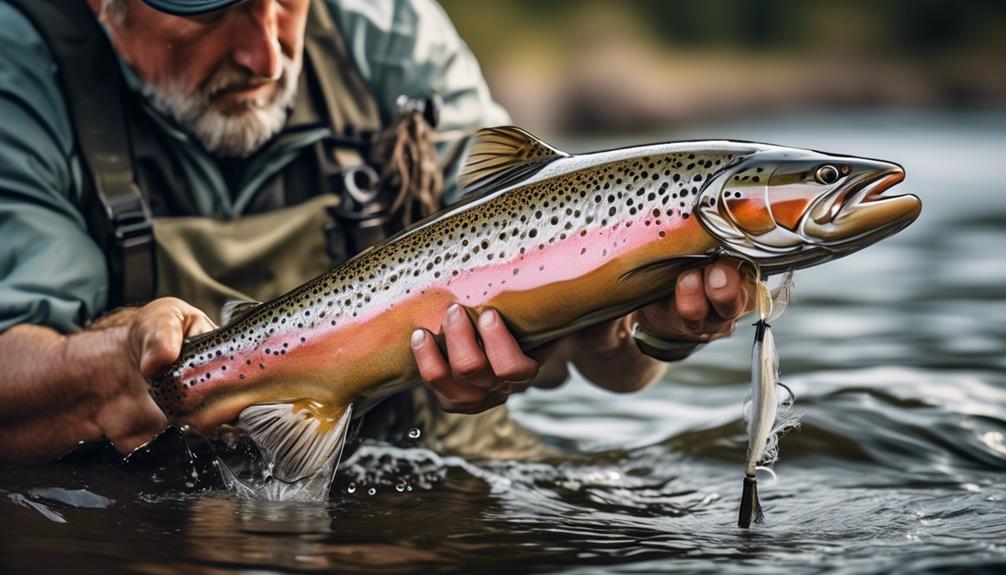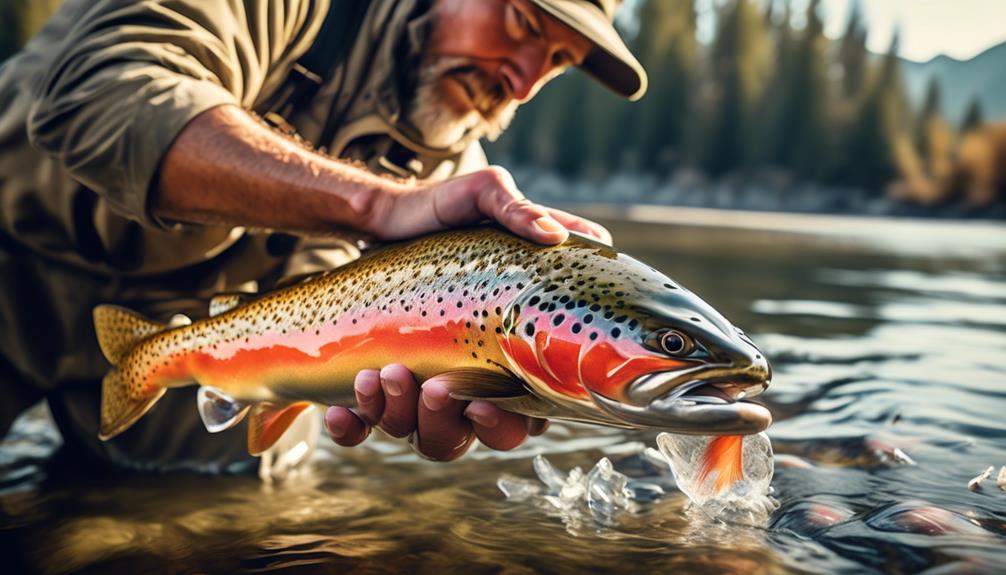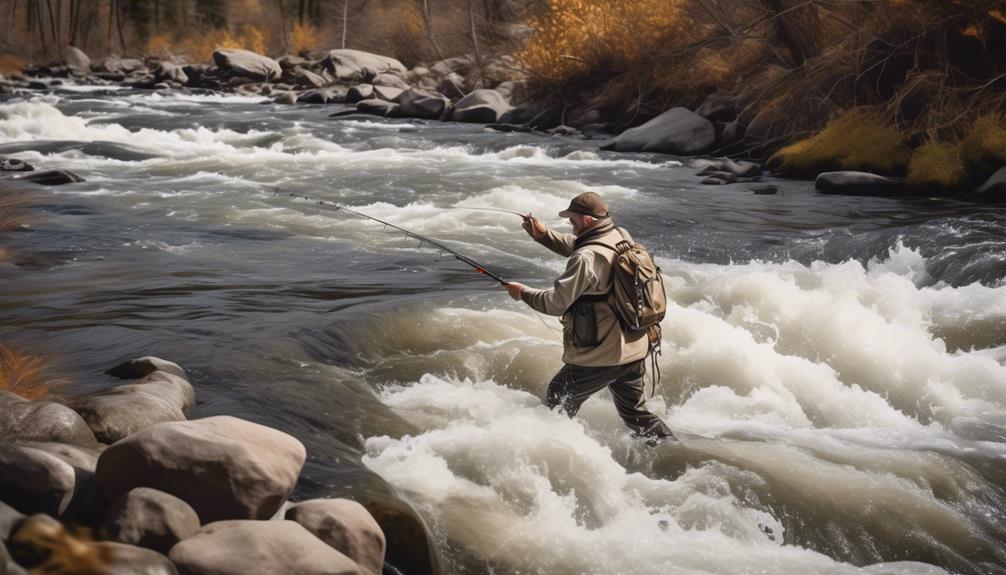Imagine yourself as a steward of the rivers and streams, where the delicate balance of aquatic life is like a finely spun web of interconnected ecosystems.
As a fly angler, you hold a unique position as both participant and protector in this intricate tapestry.
Understanding the importance of effective catch-and-release techniques is not just a matter of conservation, but a responsibility to ensure the future health of fish populations.
So, how can you navigate this balance with skill and care?
Importance of Catch-and-Release
Why is catch-and-release fishing crucial for preserving fish populations and ecosystems? Ethical angling and sustainable practices are at the core of responsible fishing, and catch-and-release plays a pivotal role in ensuring the environmental impact of angling is minimized.
By practicing catch-and-release, anglers can help maintain fish populations at healthy levels. When fish are caught and then released, it allows them to continue to contribute to the ecosystem by reproducing and maintaining balance within their habitats. This sustainable practice is essential for preserving various species of fish and the overall health of aquatic environments.
When done properly, catch-and-release fishing minimizes harm to fish. Using barbless hooks, handling fish with wet hands, and minimizing air exposure can all contribute to the well-being of the fish post-release. This ethical approach to angling ensures that fish aren't unnecessarily stressed or injured, increasing their chances of survival after being released back into the water.
Furthermore, catch-and-release fishing promotes responsible stewardship of natural resources. It allows anglers to enjoy the sport of fishing while also safeguarding the environment for future generations. By understanding the environmental impact of their actions and implementing sustainable practices such as catch-and-release, anglers can actively contribute to the preservation of fish populations and the overall health of aquatic ecosystems.
Proper Handling Techniques
What are the best practices for handling fish to ensure their well-being after catch-and-release? Proper handling techniques are crucial for minimizing fish stress and increasing their chances of survival. When you catch a fish, the first step is to keep it in the water as much as possible. This is especially important during warmer months when water temperature can significantly impact a fish's stress levels. Warm water holds less dissolved oxygen, making it harder for fish to recover from the stress of being caught.
If you must handle the fish, wet your hands before touching it to avoid removing its protective slime layer, which helps prevent infections. Avoid putting unnecessary pressure on the fish's internal organs, and refrain from squeezing it tightly. Instead, gently support the fish under its belly and at the base of its tail.
If you need to unhook the fish, do it quickly and efficiently, using a pair of needle-nose pliers or a hook remover. If the fish is deeply hooked and removing the hook could cause further harm, cut the line as close to the hook as possible.
Selecting Barbless Hooks
When choosing barbless hooks for fly fishing, prioritize those made with high-quality materials to minimize harm to the fish and facilitate safe catch-and-release. Barbless hooks offer several benefits that contribute to the well-being of the fish and the environment, making them a responsible choice for conservation-minded anglers.
Consider the following when selecting barbless hooks:
- Reduced Harm: Barbless hooks cause less damage to the fish's mouth, reducing the risk of injury and allowing for a quicker and safer release back into the water. This fosters a sense of compassion and empathy towards the well-being of the fish, aligning with the principles of ethical angling.
- Environmental Impact: Using barbless hooks demonstrates a commitment to environmental stewardship by minimizing the impact on fish populations. This can evoke a sense of responsibility and pride in contributing to the preservation of aquatic ecosystems.
- Ethical Considerations: Opting for barbless hooks reflects a dedication to ethical fishing practices, promoting a sense of respect for the sport and the natural world. This can foster a feeling of satisfaction and fulfillment in knowing that you're engaging in fly fishing in a conscientious and considerate manner.
Additionally, knowing effective hook removal techniques is crucial when using barbless hooks to minimize handling time and stress on the fish. Being mindful of these factors can enhance your fly fishing experience and contribute to the conservation of fish populations for future generations.
Using Knotless Landing Nets
When landing fish during fly fishing, opt for knotless landing nets to minimize harm to the fish and facilitate safe catch-and-release. Knotless landing nets are designed to be gentle on fish, reducing the risk of damaging their delicate scales and fins. When using a landing net, ensure that it's made of eco-friendly materials such as rubber or silicone, which are less likely to remove the protective slime layer that covers the fish. This slime layer is crucial for the fish's protection against infections and parasites.
To maintain the effectiveness of knotless landing nets, it's essential to regularly clean and inspect them. Rinse the net with freshwater after each use to remove any debris or slime, and avoid using harsh chemicals that could harm the fish or the environment. Periodically check the net for any signs of wear and tear, and replace it if there are any damaged areas that could potentially harm the fish.
Additionally, consider the size of the landing net when making a purchase. Ensure that the net is large enough to comfortably accommodate the size of the fish you expect to catch. A properly sized net will make it easier to land the fish without causing unnecessary stress or injury.
Minimizing Fight Time
To further prioritize the well-being of the fish and enhance your catch-and-release experience, aim to minimize the fight time when reeling in your catch during fly fishing. Reducing stress on the fish is crucial for their survival after being released back into the water. Quick landing techniques not only decrease the time the fish spends struggling but also increase their chances of survival once they're released.
To achieve this, consider the following:
- Stay calm and focus: By maintaining a steady rhythm when reeling in the fish, you can minimize the time it spends fighting. This reduces stress on the fish and helps to ensure its well-being post-release.
- Use appropriate tackle: Opt for the right tackle and gear that allows you to control the fight without overexerting the fish. This enables you to bring the fish in quickly, minimizing its stress and fatigue.
- Handle with care: Once the fish is landed, handle it gently and swiftly to remove the hook and release it back into the water. Quick and careful handling further reduces stress and increases the likelihood of the fish swimming away strongly.
Consideration for Fish Health
For optimal fish health during catch-and-release, prioritize minimizing fight time and handling with care to reduce stress on the fish.
Fish stress is a significant concern during catch-and-release fishing. When a fish is hooked, it can experience physiological stress responses, such as increased heart rate and lactic acid buildup in the muscles. The longer the fight time, the more exhausted and stressed the fish becomes, which can have a detrimental impact on its health.
To minimize fish stress, use appropriate tackle to reduce fight time and land the fish as efficiently as possible. This will help in maintaining the fish's health and ensuring its survival after release.
In addition to minimizing fight time, handling the fish with care is crucial for its well-being. When handling the fish, wet your hands to avoid removing the protective mucous layer on the fish's skin, which can make it more susceptible to infections. Keep the fish in the water as much as possible, and avoid squeezing or putting excessive pressure on its body. Proper handling techniques can significantly reduce the stress experienced by the fish and improve its chances of survival after being released.
It's important to recognize that the environmental impact of catch-and-release fishing is closely tied to the health of the fish. Stressed fish are more vulnerable to predators and less likely to recover after being released. By prioritizing fish health through minimizing fight time and handling with care, anglers can contribute to the conservation of fish populations and the overall health of aquatic ecosystems.
Handling and Releasing Big Fish

Ensure proper support for the fish's body when handling and releasing big fish to minimize stress and maximize its chances of survival. When dealing with large fish, it's crucial to employ proper techniques to minimize stress and ensure their well-being. Remember, these magnificent creatures play a vital role in maintaining the balance of aquatic ecosystems.
Here are a few important points to consider when handling and releasing big fish:
- Gentle Handling: Imagine the fish as a delicate being, carefully cradling its body and providing the necessary support to minimize any potential harm. The gentler you are, the better their chances of recovery and survival.
- *Emotional Appeal*: Envision the awe-inspiring beauty of a large fish gracefully swimming back into its natural habitat, contributing to the overall health of the ecosystem.
- Quick Release: Visualize the thrill of watching a majestic fish swiftly propel itself back into the depths, unharmed and undeterred. By minimizing the time spent out of the water, you're enhancing its likelihood of a full recovery.
- *Emotional Appeal*: Picture the sense of satisfaction in knowing that you've contributed to the preservation of a magnificent creature for future generations to admire.
- Proper Revival: Envision the satisfaction of witnessing a once-tired giant swiftly darting away, invigorated and ready to thrive once more. Utilize proper techniques to ensure the fish is fully revived before releasing it.
- *Emotional Appeal*: Consider the profound joy of knowing that your actions have given a magnificent fish a renewed lease on life, allowing it to continue its journey in the waters.
Educating Other Anglers
Educating other anglers about the importance of properly handling and releasing big fish is crucial for promoting sustainable fly fishing practices and preserving the health of aquatic ecosystems. Promoting awareness among fellow anglers about catch-and-release best practices can significantly contribute to the conservation of fish populations and their habitats. Sharing experiences of successful catch-and-release can be a powerful way to inspire others to adopt responsible fishing techniques.
When you're out on the water and you land a big fish, take the opportunity to demonstrate proper handling and release techniques to other anglers around you. Show them how to minimize handling time, use barbless hooks, and support the fish in the water until it's ready to swim away. Encourage others to use appropriate tackle and to be mindful of fighting times to reduce stress on the fish. By actively engaging with fellow anglers and leading by example, you can have a direct impact on the preservation of fish populations.
Additionally, consider organizing or participating in educational events or workshops focused on catch-and-release practices. Sharing your own experiences and lessons learned can effectively illustrate the benefits of responsible fishing. Whether it's through social media, local fishing clubs, or informal gatherings, taking the time to educate and engage with other anglers can create a ripple effect of positive conservation practices within the fly fishing community.
Together, we can ensure that future generations can continue to enjoy the thrill of fly fishing while safeguarding the natural environment.
Frequently Asked Questions
How Can I Tell if a Fish Is Stressed After Being Caught and Released?
After you catch and release a fish, pay attention to its behavior. If it's stressed, it may swim awkwardly or seem disoriented. Use proper handling techniques and release it gently to minimize stress and give it the best chance of survival.
What Are Some Common Mistakes Anglers Make That Can Harm Fish During Catch-And-Release?
When handling fish, common mistakes can harm them during catch-and-release. Stress indicators include lack of equilibrium and erratic swimming. Proper release technique involves minimizing air exposure, avoiding contact with dry surfaces, and providing gentle support until the fish swims away.
Are There Any Specific Regulations or Guidelines for Catch-And-Release in My Local Fishing Area?
In your local fishing area, it's crucial to be aware of specific regulations and guidelines for catch-and-release. Educate yourself on conservation practices to minimize fish stress, especially in sensitive hooking areas. Understanding these rules is essential for angler conservation efforts.
What Should I Do if I Accidentally Hook a Fish in a Sensitive Area, Such as the Gills or Eyes?
If you accidentally hook a fish in a sensitive area, like the gills or eyes, use first aid techniques to minimize harm. Handle the fish carefully, avoid causing further injury, and release it using proper release strategies.
How Can I Educate Other Anglers About the Importance of Catch-And-Release and Conservation Practices?
To educate other anglers about catch-and-release and conservation, consider hosting conservation workshops and advocacy campaigns. Distribute educational materials and use outreach strategies to spread awareness. Collaborate with local organizations to amplify your message and make a positive impact.
Conclusion
So next time you're out on the water, keep these tips in mind to ensure the health and conservation of the fish population.
By practicing catch-and-release and using proper handling techniques, you can make a positive impact on the environment and the future of fly fishing.
Educate your fellow anglers and continue to spread awareness about the importance of conservation in the sport.
Happy fishing!



